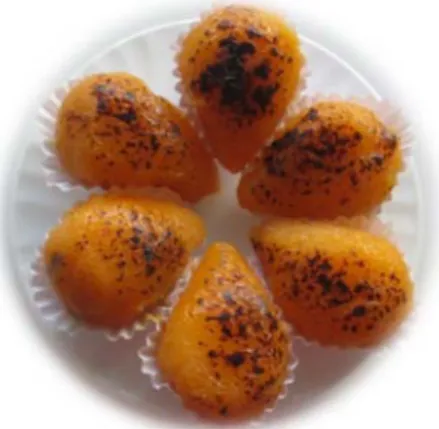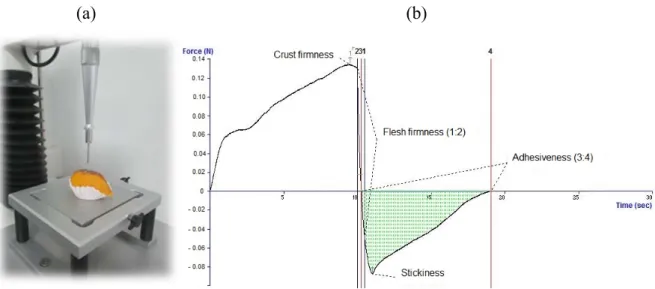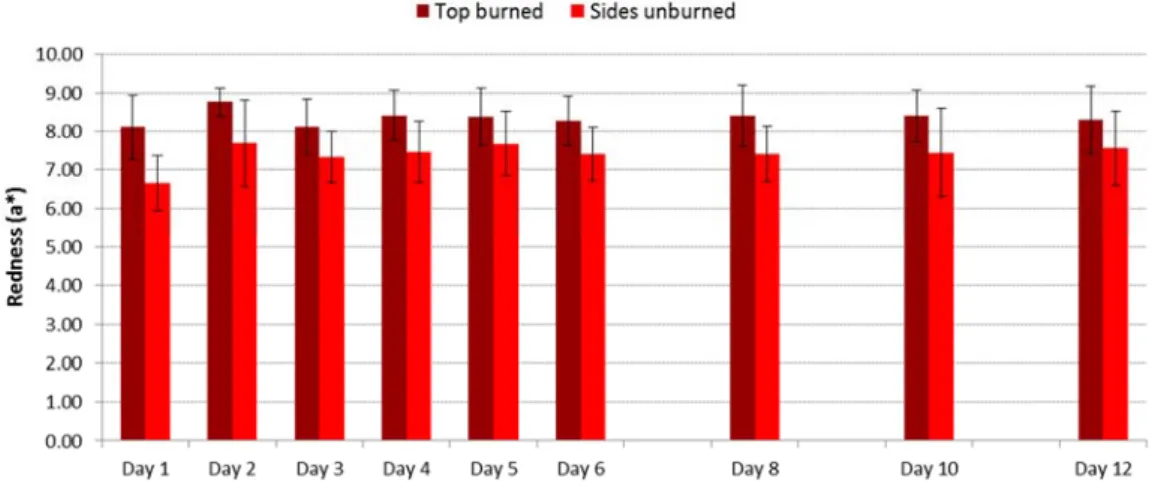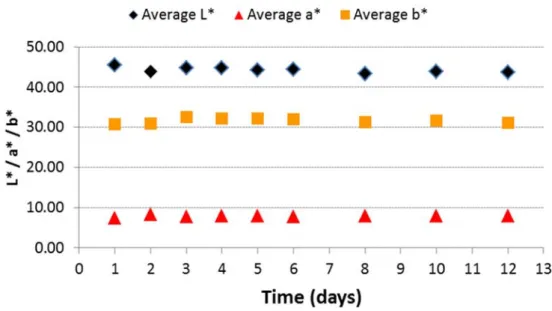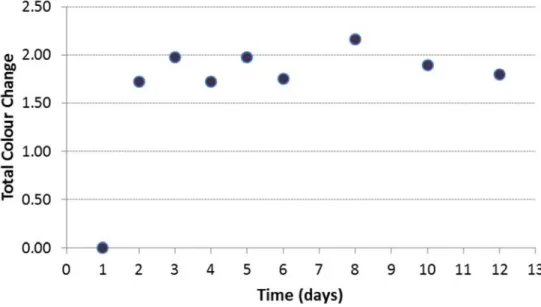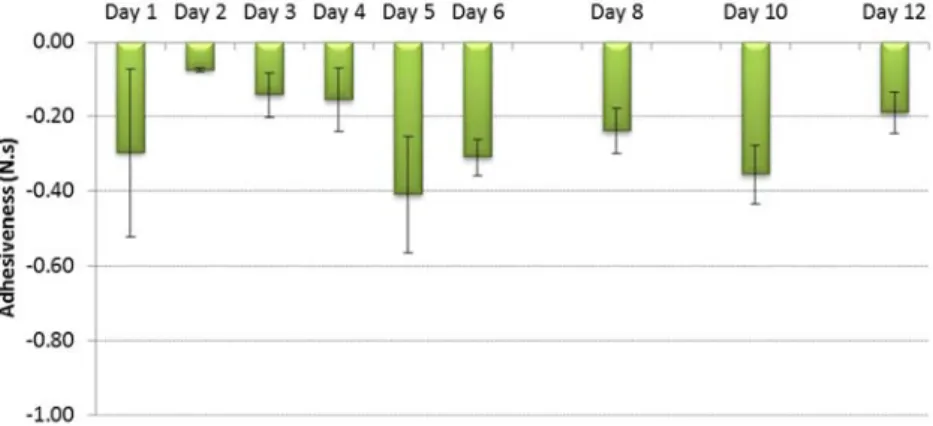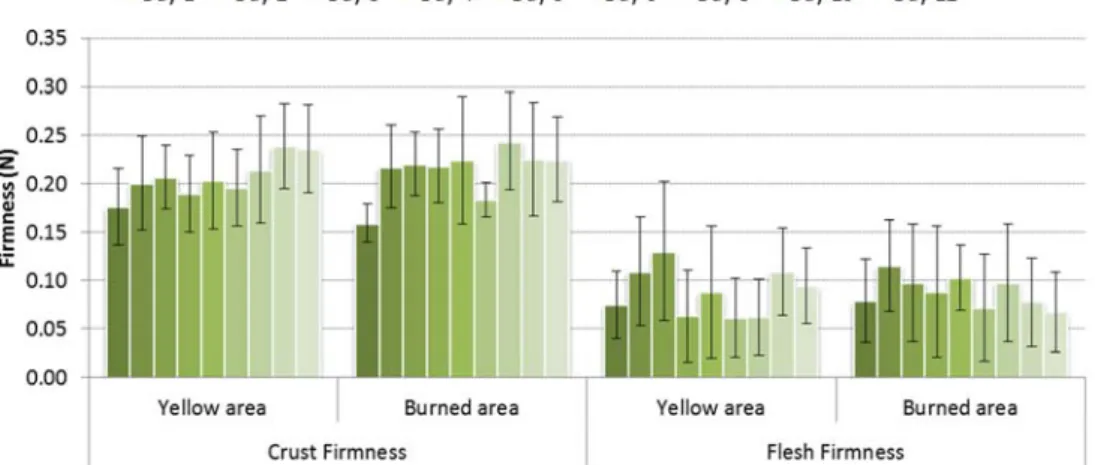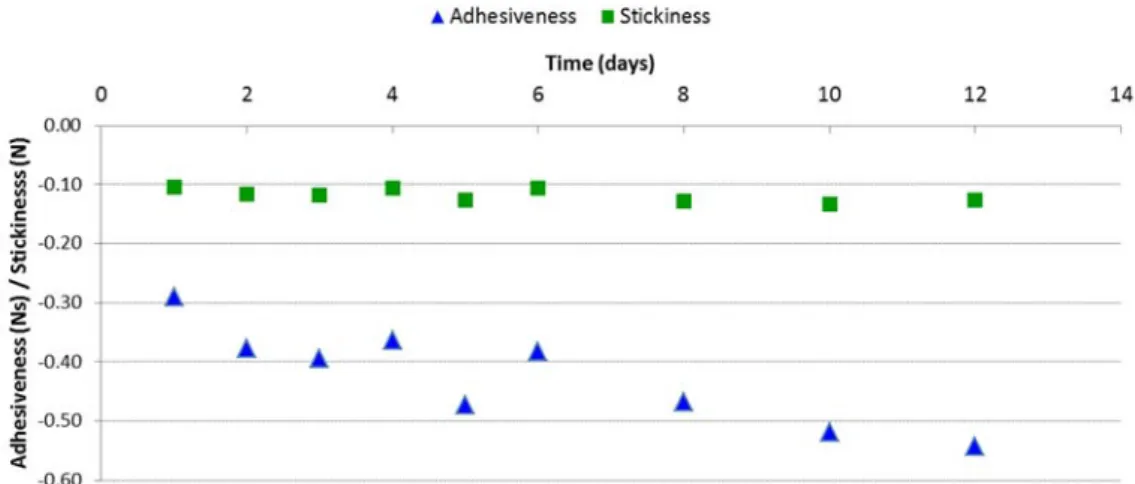Page 160
EVALUATION OF COLOUR AND TEXTURE OF A PORTUGUESE TRADITIONAL SWEET: “EGG CHESTNUT”
Raquel P. F. Guiné
CI&DETS, Polytechnic Institute of Viseu, Portugal CERNAS, Polytechnic Institute of Coimbra, Portugal Abstract
This work aimed to evaluate the colour and texture of a Portuguese traditional sweet “egg chestnuts” along a storage period of 12 days under refrigeration. For this, the colour coordinates were measured through a colorimeter and the textural parameters were evaluated by compression and puncture tests using a textutrometer. The results showed that the colour coordinates do not vary along time, corresponding to very low values of total colour difference. Hardness, chewiness and springiness decreased in the first 3 days but after that the values were maintained approximately constant. In contrast, resilience and cohesiveness did not change along time. While crust firmness increased along storage, both the flesh firmness and stickiness did not change. The adhesiveness measured through the penetration test decreased considerably from the first to the last day. Hence, it was concluded that colour is better preserved than texture along a 12 day storage period under refrigeration.
Key words: traditional sweet, characterization, egg chestnuts, texture, colour
1. INTRODUCTION
Food represents far beyond the role human nutrition, playing other roles in people’s daily life, beliefs, and socioeconomics. Food has many symbolic meanings, being also associated with religion and social events. Food helps expressing and establishing the relationship between people and their environment as well as between people and their beliefs. In this way, food is an important component of every society (Ma, 2015).
The preservation of a people’s identity is unquestionably also linked to traditional foods, apart from other factors. See as example the Mediterranean diet, recognized as Intangible World Heritage by UNESCO. The Mediterranean diet, first identified as a healthy diet in the middle of the 20th century, after the end of World War II, is characterized by a high intake of vegetables, legumes, fruit, cereals (particularly whole non-refined cereals), fish, and monounsaturated fats (most specially, olive oil); a moderate intake of milk products such as cheese and yogurt; moderate consumption of alcohol (wine); and a low intake of saturated fats and red meat (Nissensohn et al., 2016; Noale et al., 2014)
It’s been more than 20 years ago that the European Union (EU) introduced measures to regulate certification schemes and to promote them as a means of developing opportunities and preserving the traditional characteristics of certain foods and/or processes for food production. The certification schemes include the Protection of Designated Origins (PDO), the Protected Geographic Indication (PGI) and Traditional Speciality Guaranteed (TSG) (Conneely and Mahon, 2015). These measures Although the diversity of Portuguese sweets is enormous, only a very limited number has been officially recognized by the European Commission as IGP: a) “Pastel de Chaves”: a traditional specialty consisting of a kind of fine rolling with minced meat inside, with the particular flavour of the ingredients from the region around the city of Chaves; b) “Pastel de Tentúgal”: a monastic sweet typical of Portugal, made since the late nineteenth century, created by the Carmelite nuns of the Carmel of Tentúgal, and known for its very fine and unique puff pastry; c) “Ovos moles de Aveiro”: typical from the city of Aveiro, its filling is made from extremely fresh egg yolks mixed exclusively with sugar at the right heating point, resulting in a very creamy texture. Still, the importance of all other Portuguese traditional sweets is unquestionable, being one of the main gastronomic attractions, conquering the many foreign people who visit Portugal, apart from delighting the Portuguese. One Portuguese sweet that has become an icon is the “Pastel de Belém” or “Pastel de
Page 161
nata”, which apart from being widely consumed in Portugal is also nowadays exported in huge quantities to different parts of the world.
The Portuguese speciality “castanhas de ovos” (in English translated to egg chestnuts) is original from Viseu and benefits from the convent influences that were greatly felt in this town, especially with the coming of the nuns of St. Benedict, from the Convent situated in Ferreira de Aves, to the Convent of the same Order installed within one of the entrances of the city. Its name derives from the shape resembling a chestnut, and the burned tonality of the surface also similar to the brown of the chestnut. The objective of this work was to give a contribution for the characterization of the Portuguese traditional sweet “egg chestnuts”, through the evaluation of its colour and texture, which are two main quality attributes of this convent sweet. Furthermore, and because the shelf-life of this product is typically long (up to 30 days under refrigeration), the variations along time were also evaluated to verify whether these sensorial characteristic of the product are much influenced by storage time. 2. MATERIAL AND METHODS
2.1. Samples
The samples were bought from a pastry situated in the city of Viseu (Confeitaria Amaral), having been produced according to the traditional recipe and made specifically for this work. The confectionary procedure is as follows: boil 250 g of sugar until pearl point and then join 250 g of grated almonds, letting boil for a few minutes before taking out of the heat. Add 10 homogenised egg yolks and take the mixture again to the heat, constantly mixing until a suitable consistency is achieved. When cold, use the mass to tend the chestnuts, that are then covered with egg yolk using a brush and finally burned wither by using a hot metal or a flamethrower. The egg chestnuts used for this work were made in the day they were bought to be analysed. The samples were as shown in Figure 1.
Also, a set of samples were stored under refrigeration at +4 ºC, for repetition of the analyses over time, up to 12 days. In the first 6 days the evaluations were done daily, and after that they were made every two days.
Figure 1. Portuguese traditional sweet: “egg chestnuts”.
2.2. Colour evaluation
Colour can be evaluated instrumentally using the CIELAB coordinate system defined by the Commission Internationale de L'éclairage - 1976. CIE L*, a* and b * were measured using a portable colorimeter Chroma Meter CR-400 from Konica Minolta. The L* coordinate expresses the lightness, ranging from 0 (black) to 100 (white), the coordinate a* goes from -60 (green) to +60 (red) and the coordinate b* varies from -60 (blue) to +60 (yellow) (Barroca et al., 2013). For the evaluation of
Page 162
colour were made 6 measurements on the top burned of the sample plus 6 other measurements on the sides (unburned), and these were repeated on a different sample (Figure 2). The exact same samples were evaluated along time, since this analysis is non-destructive.
Figure 2. Evaluation of colour using a colorimeter.
The total colour change (E), was the variable considered for the overall colour difference evaluation, between a sample and the reference sample (designated with an index 0) on equation (1):
E = (L0 -L)2 + (a0 - a)2 + (b0 - b)2 (1)
As reference was considered the colour of the samples in the first day, i.e., right after production, and a larger E denotes greater colour change in relation to the reference material (Guiné and Barroca, 2012). 2.3. Texture evaluation For the analysis of textural parameters was used a texturometer TA-XT2 (Stable Microsystems) and two types of test were performed: Compression test and Puncture test. 2.3.1. Compression test The texture profile analysis was carried out by two compression cycles between parallel plates performed on the samples using a flat compression probe 75 mm in diameter (P / 75), with a 5 seconds interval between cycles. The parameters that have been used were the following: 30 kg force load cell, Pre-test, test and post-test speed equal to 1.0 mm/s, distance 5 mm and trigger force 0.1 N. The textural properties: hardness, adhesiveness, resilience, springiness, cohesiveness, and chewiness were calculated after equations (2) to (7) (see Figure 3) (Guiné et al., 2015; Guiné and Barroca, 2012).This test was done once in each sample, using different samples to obtain repetitions. Hardness (N) = F1 (2)
Adhesiveness (Ns) = A3 (3)
Resilience (%) = (A5/A4) x 100 (4)
Springiness (%) = (T2/T1) x 100 (5)
Page 163
Chewiness (N) = F1 x (T2/T1) x (A2/A1) (7)
Figure 3. (a) Evaluation of texture by the compression test; (b) Typical texture profile analysis (TPA) obtained for the egg chestnut.
2.3.2. Puncture test
To perform the puncture test it was used a drilling rig 2 mm in diameter. The pre-test speed was 2 mm/s and the test and post-test speed were 1 mm/s. The distance was 10 mm and the trigger force 0.05 N. The texture parameters analysed with this test were: crust firmness, flesh firmness, adhesiveness and stickiness. This test was repeated multiple times in each sample corresponding to punctures in different zones (4 in the burned zone and 4 in the unburned zone) and also different samples were evaluated for repetitions.
Figure 4. (a) Evaluation of texture by the puncture test; (b) Typical puncture curve obtained for the egg chestnut.
(a) (b)
Page 164 3. RESULTS AND DISCUSSION
3.1. Colour
Figure 5 presents the values of lightness evaluated along the 12 days separately in the top of the egg chestnut, which corresponds to the burned area, and on the sides, corresponding to the unburned area. The results show that lightness on the top (burned area) is systematically lower than on the sides (unburned), indicating that the burned area is darker (values of L* approaching zero, which represents black). On the other hand, the values of L* for the unburned area are slightly over 50, tending more to 100, which represents white, thus being clearer. In the first day, L* was equal to 38.77±3.69 and 51.95±2.39 for the top (burned) and sides (unburned), respectively. Finally, it is important to notice that the lightness did not change along time, thus maintaining values closer to those on the manufacture day.
Figure 5. Variation of lightness (L*) in the different areas of the egg chestnuts along time.
The results for the colour coordinate a*, representing redness for positive values, are shown in Figure 6 and they indicate that the top of the egg chestnuts presents s more intense red when compared to the sides (unburned). This would be expected also, because the burning produces a brownish colour, with more red when compared to the unburned areas. The initial values of a* werere 8.10±0.83 and 6.65±0.72 for the top and sides, respectively. Regarding the evolution along storage time, it was observed a slight increase in day 2 but a trend to stabilize after that.
Page 165
Figure 7 presents the intensity of the yellow coloration (given that the values of b* area positive) on the egg chestnuts, also considering the top (burned) and the sides (unburned) separately. As expected, in the unburned area the intensity of the yellow is much higher when compared to the burned area. In the first day of evaluation, the initial values of b* were 39.04±4.22 and 22.39±5.40 for the unburned and burned areas, respectively Furthermore, and as previously seen for other colour parameters, no variations along time were registered in the yellow coloration.
Figure 7. Variation of yellowness (b*) in the different areas of the egg chestnuts along time.
Figure 8 represents the evolution of the colour coordinates, considering the average between the burned and the unburned areas, thus corresponding to the average colour of the egg chestnuts seen as a whole. Just a very slight decrease in L* is observable from day 1 to day 2, while the other opposing colour coordinates (a* and b*) remain approximately constant along the 12 days of storage. In the first day the samples were put into the refrigerator after being analysed, and that might be responsible for this slight effect, not observed in the other days, since the samples were always maintained in the same ambient after that.
Figure 8. Variation of the colour parameters in the egg chestnuts along time, considering the whole sample.
Page 166
Figure 9 shows the values of the total colour difference (E, as calculated though Equation (1)), which has a value of zero for the first day because that was the colour considered as reference. On the other days the value of E presents some slight oscillations varying in the range from 1.7 to 2.2, thus corresponding to a practically negligible colour difference. These results indicate that the colour of the egg chestnuts is perfectly preserved during a storage period of 12 days, when kept under refrigeration.
Figure 9. Evaluation of the total colour difference along time.
3.2. Texture
3.2.1. Compression test
Figure 10 shows the textural properties hardness and chewiness of the egg chestnuts, along the 12 days of observation. The hardness is related to the force required by mastication that takes part during eating (Guiné and Barroca, 2012), while the chewiness corresponds to the work needed to masticate the sample to a consistency suitable for swallowing (Cruz et al., 2015). The results in Figure 10 show that both properties present a similar variation trend, being this expected, given that chewiness is strongly related to hardness. The values of hardness and chewiness in the first day were 2.18±0.31N and 0.91±0.24 N, respectively, whereas in the last day (day 12) they were 2.12±0.06 N and 0.83±0.01 N. As to the variations along time from day 1 to day 3 a decrease in hardness was observed, which might be related to the introduction of the samples into the refrigerator, with a typical moisture abundant atmosphere, thus corresponding to a possible slight increase in the moisture content of the samples, producing their softening. After that, the hardness varied just slightly around a value of 2 N. The trend for chewiness was naturally similar, just with lower absolute values.
Figure 11 presents the textural properties springiness, resilience and cohesiveness. Springiness is a measure of recovering height after releasing from the compression in mastication; resilience is how well a product resists to regain its original position, representing an instant springiness; and cohesiveness refers to the internal forces that keep the sample cohesive and measures the degree to which the sample deforms before rupturing (Cruz et al., 2015; Guiné and Barroca, 2012). The results show for springiness a similar trend as that previously described for hardness and chewiness, while resilience ad cohesiveness practically do not change at all along the 12 days of observation. In the first day the values for springiness, resilience and cohesiveness were, respectively, 69.20±5.80%, 21.49±0.96% and 53.90±2.69%, being on the last day equal to 68.65±2.33%, 21.81±0.38% and 54.60±0.71%, respectively.
Page 167
Figure 10. Variation of hardness and chewiness in the egg chestnuts along time.
Figure 11. Variation of springiness, resilience and cohesiveness in the egg chestnuts along time.
Adhesiveness represents the force required to remove the material that adheres to a surface (Guiné et al., 2014), and is shown in Figure 12. On the first day adhesiveness was -0.30±0.22 Ns, which is practically negligible, with the highest adhesiveness (in absolute value) being observed for day 5 (-0.41±0.16 Ns).
Page 168 3.2.2. Puncture test
The interest in performing different texture experiments resides in evaluating different textural attributes. For example, while the compression test consists in compressing the sample between the probe and the platform, the puncture test consists in perforating the sample with the probe, thus allowing evaluating the work done entering the sample and leaving it again, just like if it were a tooth entering a food in the mouth. Figure 13 shoes the resistance offered to the probe when perforating the surface of the egg chestnut (crust firmness) and when it goes inside it (flesh firmness). Again, the burned and unburned areas were separated for evaluation of the possible differences. While the crust firmness tends to increase along time in both the burned and unburned areas, the flesh firmness presents some variations but not a visible increase or decrease trend along time, being this valid for both the burned and unburned areas. Hence, no visible differences are seen when comparing the burned with the unburned areas, but, on the other hand, a marked difference is observed when comparing the crust firmness with that on the flesh. In fact this is expected, since the crust tends to be harder when compared to the flesh, which is softer as a result of the protection offered by the crust.
Figure 13. Crust and flesh firmness in the egg chestnuts along time.
Figure 14 shows the stickiness and the adhesiveness, now measured inside the sample, contrarily to the compression test where the adhesiveness was measured on the surface only. The values of stickiness are very low, under 0.2 N, in both the burned and unburned areas. Regarding adhesiveness, it was observed a trend to an increase along time (in absolute values), being also higher in the burned area as compared to the unburned area. Furthermore, it is important to notice that the values of adhesiveness are higher when the probe penetrates the sample as compared to those obtained when the probe compresses the surface (compression test – Figure 12).
Figures 15 and 16 present the evolution during the evaluation time of the crust and flesh firmness as well as adhesiveness and stickiness, this time considering the whole sample, i.e., calculating average values between the burned and unburned areas. The results in Figure 15 show that crust firmness increased from day 1 to day 2, corresponding to the entrance in the refrigerator, but maintaining approximately constant thereafter. On the other hand, the flesh firmness practically did not change from day 1 to day 12, although manifesting some oscillations. Globally the variations in crust and flesh firmness were, from day 1 to day 12, respectively 39% and 3% (in relation to the values in day 1 considered as reference).
Page 169
Figure 14. Stickiness and adhesiveness in the egg chestnuts along time.
Figure 15. Global variation of firmness in the egg chestnuts along time.
In Figure 16 is visible that, while stickiness remains almost constant over time, varying from -0.10 N to 0.13 N (from day 1 to day 12), adhesiveness decreases considerably from day 1 to day 12 (from -0.29 N to -0.54 N, corresponding to an increase by 87%).
Page 170 4. CONCLUSIONS
The present work allowed concluding that the colour of the egg chestnuts is perfectly preserved after a 12 day period of storage, with very low values of total colour difference. Regarding hardness, chewiness and springiness, it was observed a decrease in the first 3 days then maintaining approximately constant values until the last day of evaluation. Contrarily, resilience and cohesiveness did not change along time during the 12 day period of evaluation. While crust firmness increased along time, the flesh firmness did not vary and the same was observed for stickiness. On the other hand, the adhesiveness measured through the penetration test decreased considerably from the first to the last day. In view of these conclusions, it is possible to affirm that colour of the egg chestnuts is better preserved than texture along a 12 day storage period under refrigeration.
ACKNOWLEDGMENT
The authors thank CI&DETS Research Centre and Polytechnic Institute of Viseu, Portugal, for financial support.
REFERENCES
Barroca, M.J., Guiné, R., Alves, M., Oliveira, S., Gonçalves, F., Correia, P., 2013. Effect of drying on the properties of pears cv. D. Joaquina, in: Proceedings of the VII Congreso Ibérico de Agroingeniería Y Ciencias Hortícolas. Madrid, Espanha, p. Ref. C0115, 6pp.
Conneely, R., Mahon, M., 2015. Protected geographical indications: Institutional roles in food systems governance and rural development. Geoforum 60, 14–21. doi:10.1016/j.geoforum.2015.01.004
Guiné, R., Correia, P., Correia, A.C., 2015. Avaliação comparativa de queijos de cabra e ovelha. Millenium 49, 111–130.
Guiné, R.P.F., Barroca, M.J., 2012. Effect of drying treatments on texture and color of vegetables (pumpkin and green pepper). Food Bioprod. Process. 90, 58–63. doi:10.1016/j.fbp.2011.01.003
Ma, G., 2015. Food, eating behavior, and culture in Chinese society. J. Ethn. Foods 2, 195–199. doi:10.1016/j.jef.2015.11.004
Nissensohn, M., Román-Viñas, B., Sánchez-Villegas, A., Piscopo, S., Serra-Majem, L., 2016. The Effect of the Mediterranean Diet on Hypertension: A Systematic Review and Meta-Analysis. J. Nutr. Educ. Behav. 48, 42–53.e1. doi:10.1016/j.jneb.2015.08.023
Noale, M., Nardi, M., Limongi, F., Siviero, P., Caregaro, L., Crepaldi, G., Maggi, S., 2014. Adolescents in southern regions of Italy adhere to the Mediterranean diet more than those in the northern regions. Nutr. Res. 34, 771–779. doi:10.1016/j.nutres.2014.08.001
